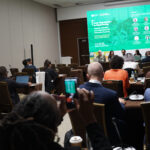Restoration Pavilion inspires on day three with visionary sessions on nature-based solutions, innovation and collaboration

Gilles Amadou Ouédraogo of UNCCD during his presentation at the Restoration Pavilion, highlighting the role of data in measuring progress in land restoration, on 4 December 2024, in Riyadh, Saudi Arabia.
Photo credit: UNCCD/G20 Global Land Initiative
The energy at the Restoration Pavilion on the third day of COP16 was palpable, with each session reinforcing the urgency of climate action and the need for collaborative solutions. “The Pavilion is a testament to the power of community, innovation, and shared purpose,” said a participant.
Participants from across the globe explored innovative solutions, community engagement strategies and the critical role of public-private partnerships in fostering sustainable ecosystems.
Throughout the day, speakers emphasized the importance of reconnecting urban environments with nature. In the session Developing Nature in the Cities and Resilient Communities, Phillip Dunn and Sajid Pareeth from Expo City Dubai captivated the audience with insights on integrating green spaces into urban planning.
“We need to ensure cities are not just spaces for living but ecosystems where people and nature thrive together,” said Dunn, showcasing Expo City’s efforts to incorporate nature-based solutions and adaptive reuse in urban design.
The session Data and Knowledge Platforms for Land Monitoring underscored the power of technology and innovation in restoration efforts. Experts from Food and Agriculture Organization of the United Nations (FAO) and World Resources Institute (WRI) demonstrated cutting-edge tools for monitoring land health and biodiversity, emphasizing how open data platforms can empower policymakers and practitioners alike.
“Data-driven decision-making is key to scaling up restoration,” noted Fidaa Fawwaz Haddad of the FAO, highlighting how platforms like SEPAL Forest and Land Monitoring for Climate Action are transforming land management strategies.
Collaboration was a recurring theme, particularly in Leveraging Public-Private Partnerships for Land Restoration. Panelists shared success stories of cross-sector alliances that mobilize resources and expertise for large-scale restoration projects. The conversation emphasized that long-term success hinges on aligning public policies with private investments.
Revegetation: A critical component in tackling Land-use driven Climate Change, Community Resilience, and Sustainable Financing from the experiences of wider Southern and Central Africa brought attention to the vital role of plant life in restoring degraded landscapes and mitigating climate change.
The session highlighted projects that prioritize native species and ecological balance, with a particular focus on how revegetation strengthens community resilience.
Education and skills development also took center stage during Nature Works – Skilling and Up-Skilling in Nature-Based Solutions. This session spotlighted training initiatives that equip individuals with the expertise needed to implement sustainable practices.
Participants praised workshops on beekeeping, mushroom cultivation and water management as powerful tools for community empowerment and job creation. “We are not just restoring land, we are building futures,” remarked a participant.
In Sowing Seeds of Faith: Cultivating a Decade of Restoration, panelists reflected on the successes and challenges of the UN Decade on Ecosystem Restoration. The session celebrated milestones while calling for renewed commitment and action.
Faith leaders and community advocates emphasized the moral imperative of environmental stewardship, inspiring attendees to see restoration as a collective mission transcending sectors and borders.
However, not all discussions focused solely on achievements. Failures in Land Restoration provided a sobering yet insightful look at lessons learned from projects that fell short of their goals.
Alexey V. Alekseenko of United Nations University- Institute for Integrated Management of Material Fluxes and of Resources (UNU-FLORES) shared candid reflections on the complexities of restoration work, from funding challenges to ecological missteps.
These conversations were framed as opportunities for growth and innovation, and a reminder to land restorers that resilience is built through perseverance and adaptability.
All day, the Pavilion was a hub of transformative ideas and meaningful dialogue featuring a compelling lineup of events aimed at advancing global land restoration efforts.
As COP16 progresses, anticipation builds for the remaining days of the Restoration Pavilion’s programming. Attendees and stakeholders are encouraged to stay engaged and participate in the upcoming sessions that promise more groundbreaking insights and actionable strategies.
The Restoration Pavilion will continue to host events until 12 December 2024. Join in land conservation as the restoration community plants the seeds for a sustainable and resilient future.




